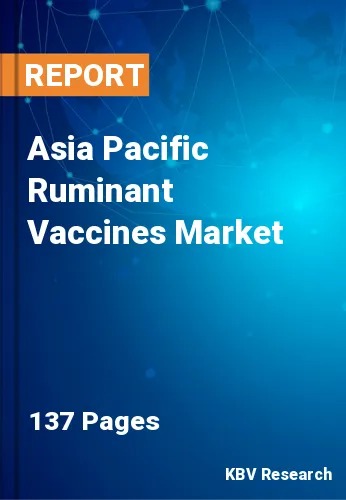The Asia Pacific Ruminant Vaccines Market would witness market growth of 7.4% CAGR during the forecast period (2024-2031).
The China market dominated the Asia Pacific Ruminant Vaccines Market by Country in 2023, and would continue to be a dominant market till 2031; thereby, achieving a market value of $441.5 million by 2031. The Japan market is registering a CAGR of 6.6% during (2024 - 2031). Additionally, The India market would showcase a CAGR of 8.1% during (2024 - 2031).

Enteric diseases are a common cause of morbidity and mortality in ruminants, leading to gastrointestinal disturbances, diarrhea, and reduced feed efficiency. Vaccines targeting enteric pathogens such as rotavirus, coronavirus, Escherichia coli, Salmonella spp., and Clostridium spp. are used to prevent diseases like calf scours, enterotoxemia (overeating disease), salmonellosis, and colibacillosis. Vaccination helps reduce the prevalence and severity of enteric infections, improve digestive health, and enhance growth performance in young and adult ruminants.
The adoption of vaccines varies across different regions, production systems, and livestock sectors. Several factors influence the adoption of ruminant. For instance, regulatory requirements for disease control, import/export regulations, and market access considerations influence the adoption of vaccination programs. Producers may be required to vaccinate their animals against specific diseases to comply with national or international health standards, gain access to export markets, or participate in disease control programs mandated by regulatory authorities.
Bovine respiratory diseases (BRD) is a widespread and economically significant disease in China’s cattle population. For instance, as per the National Library of Medicine, in China, the incidence of BRD is 50–100%, and the mortality rate is 20–50%. Extreme weather conditions, such as cold winters and temperature fluctuations between spring and autumn in Xinjiang, China, contribute to increased susceptibility of calves to respiratory diseases, including BRD. Also, respiratory illness affects 40–80% of people, with a 60–90% fatality rate. The high prevalence of BRD in China drives the demand for effective vaccines among cattle producers. Furthermore, with India being one of the largest livestock producers globally, the increasing population of ruminants, including cattle, buffalo, sheep, and goats, translates to a higher demand for disease prevention measures. The overall number of livestock in India is 536.76 million, up 4.8% from the 2012 livestock census, according to the Ministry of Fisheries, Animal Husbandry & Dairying. In 2019, there were 303.76 million bovines (buffalo, cow, yak, and mithun) worldwide, a 1.3% rise from the previous census. Hence, the rising livestock population and high rates of BRD in the region are driving the market’s growth.
Free Valuable Insights: The Global Ruminant Vaccines Market is Predict to reach USD 5.7 Billion by 2031, at a CAGR of 6.7%
Based on Animal Type, the market is segmented into Cattle, and Sheep & Goats. Based on Vaccines Type, the market is segmented into Modified/ Attenuated Live, Inactivated (Killed), and Others. Based on Route of Administration, the market is segmented into Injectable, and Intranasal. Based on Indication, the market is segmented into Bovine Respiratory Diseases (BRD), Diarrhea/ Scours, FMD, Clostridial Diseases, Leptospirosis, BVD Infection, and Others. Based on countries, the market is segmented into China, Japan, India, South Korea, Australia, Malaysia, and Rest of Asia Pacific.
By Animal Type
By Vaccines Type
By Route of Administration
By Indication
By Country
Our team of dedicated experts can provide you with attractive expansion opportunities for your business.

